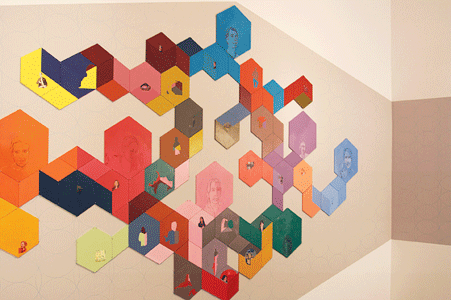Sight Plan
Dana Clancy
Saturday, March 21, 2009 to Saturday, April 25, 2009

Laconia Gallery is pleased to present Sight Plan, a large survey of paintings by local artist Dana Clancy. One group of oil paintings called Viewing Space (2008/9) initially featured at the Danforth Museum and curated by Rachael Arauz is reconfigured at Laconia. This series shows the interiors of museums populated by the viewing public. The other series Network (2008/9) is a wall sized chain of acrylic portraits based on the profile photos of her “Facebook friends” originally created for an exhibit at the Brattleboro Museum and Art Center. The difference in how we view images of people we see online, great artworks in museums or people we look at from a safe distance, remind us of how many ways there are to look. Clancy loads each work with lucid social and cultural observations surrounding these public/private visual interactions. Even as spectators, we are implicated by being part of the chain of friends, by viewing the viewers or by being seduced by the massive interior spaces.
This personal connection to the content reminds us how intimate our relationship with art (and art spaces) can be. This is how Clancy sees things; she is an artist, married to an architect, and they both enjoy visiting museums. They recognize the museum space as a built collaboration between their professional passions. Their intimate knowledge and appreciation of how space and light shape a viewing experience – their experience – is tempered by the restraint and compositional clarity needed for a museum to function as a great stage for art. Dana references the Tate Modern in London, The Guggenheim Museum in New York, the Museum of Modern Art and Mass MOCA to focus squarely on how these global brands try to attract and impress a broad audience.
In most of the works in Viewing Space, Clancy lets viewers feel the huge interior spaces and dramatic views into other parts of a museum by using a bird’s eye view of tiny museum visitors taking positions in dramatically vertiginous atriums. By shrinking the people and the art to ant sized proportions, the artist shows the art viewing experience being overwhelmed by the spaces, swallowed up in a sea of concrete or precariously perched at a precipice protected only by a thin sheet of glass. Clancy has a deft way of visualizing emotional states, spaces, and importantly, the room and color between them. Clancy negotiates the tension between the function of the space and its inherent beauty or power over the (figures and) contents it was designed to present.
Clancy’s very contemporary approach to painting atmosphere ranges from high chroma areas of flat color to deliciously modulated transitions between cool and warm, dark and light. The detailed involvement of color updates these carefully crafted works with a personal touch that tempers her vibrant cultural critique. The virtuoso painting of the mixed lighting sources and reflections in Spin (2008), for example, are coupled with descriptive gestures of tourists in the lobby of the Guggenheim Museum in New York. An odd lean, the viewer with hands behind his back dutifully clutching a visitor’s guide, or the tired figure, slumping on a museum bench are too familiar.
Dana Clancy builds meaning into her composition in Network (2008/9). The form traces connections between artists that she knows and then connects them with other friends’ portraits by linking together one or more edges forming interlocking chains of high chroma, hexagonal panels. The scale of the drawings vary from large scale portraits Clancy made of her friends who agreed to sit for her, to the tiny profile portraits printed out and painted at whatever scale they were uploaded to Facebook. They often show cheesy poses and typical web cam shots that point to their photographic online origins. The larger scale and looser linear gestures of the hand-drawn images describe the act of sitting for a portrait by overlaying several views like a long exposure, adding a sense of time to the faces.
The act of looking at a painting or a drawing based on a snapshot of a “Facebook friend” unveils the balancing act between public and private that these social networks claim to construct. Far from suspicious or pessimistic, Clancy gives us a real first hand experience, albeit second hand, by using her own friends as a well grounded starting point.
These deeply investigated ideas and the skill with which they are brought out through a broad range of scales and media give a hand-wrought visuality and intensity to topics that are usually presented dryly. Her experience and subtlety as a painter result in a deeper more nuanced description of these multifaceted civic territories as indicators of our cultural priorities.
– James Hull, Curator